-
Posts
2,616 -
Joined
-
Last visited
Content Type
Profiles
Forums
Store
Help Articles
Posts posted by Peter the eater
-
-
I've only made gravlax once. It was a several-day preparation, complete with the weights and days in the refrigerator, and mustard-dill sauce. Although I liked the result I've hesitated to invest the time to do it again. It never occurred to me that it could be expedited that way. Did you also add liquid, or just the salt and sugar?
I did not add liquid. The photo shows a syrupy substance - all that water was sucked out of the fish and it made the grains of salt and sugar disappear. It continued to change the next day or so getting darker and more firm. I figure thinner pieces of fish means a faster process.
-
I consider gravad lax (gravlax) to be one of the greatest contributions Sweden has ever made to the modern world, ahead of Ikea, ABBA and Mats Sundin. Alright, I'll include Daniel Alfredsson considering he'll be skating around with the Stanley Cup over his head in a few weeks. Can't forget Claes Oldenburg, either.
I recently made some gravlax and salmon ceviche at the same time for a side-by-side comparison. I bought a small fresh piece of Atlantic salmon and cut it into chunks and placed half into a container with 1/2 cup salt and 1/2 cup sugar. The other half went into a container with the juice of a lime and a lemon plus a few capers. I left them overnight in the fridge and got this:
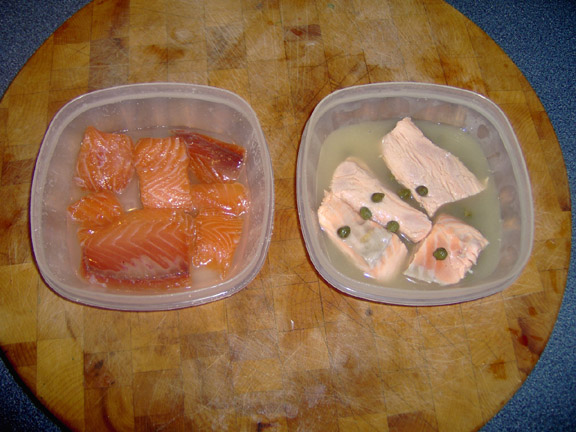
The gravlax on the left became very firm and the colour deeped, whereas the ceviche was soft and flaky and pale - similar to cooking with moist heat. I gather most would have applied a weighted pressure to the gravlax to flatten it out while curing, and they'd add dill, I did neither. As well, overnight in the fridge is longer than ideal for a traditional ceviche.
I took bits from each and put them on cukes with a little sour cream/cream cheese mixture.
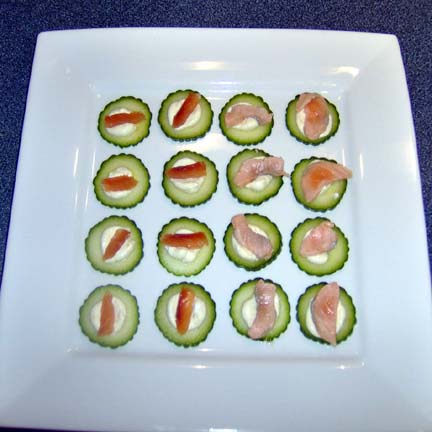
I like them both despite being very different in texture and taste. If I had to pick a winner I'd say gravlax is more appealing with its salty sweet sheen and chewiness. It seemed as good or better than the comparable product at the grocery store, which has a considerable mark-up beyond the price of raw salmon.
The ceviche was more like a cold piece of poached salmon with a little citrus dressing. Both are really tasty, easy and affordable, and faster than smoking.
-
I would like to taste your crab and know the difference between it and our Dungenous crab.
I haven't had Dungenous (Dungeness?) crab since living in Vancouver over a decade ago, but if memory serves they are very similar: sweet, tender, slightly stringy white meat. They kind of look the same, too.
-
One more topical blooper from the archives!
I have some extended family in New Brunswick, one province over. They have a long-standing tradition of baking soldier beans overnight with pork and molasses and various spices, in an cast iron pot, and buried in the ground over smoldering coals. For the record its called "Uncle Jimmy's Bean Hole". This was something I had to do. I followed all the instructions and slept well that night in eager anticipation. Well the morning's "big reveal" didn't go quite as planned:
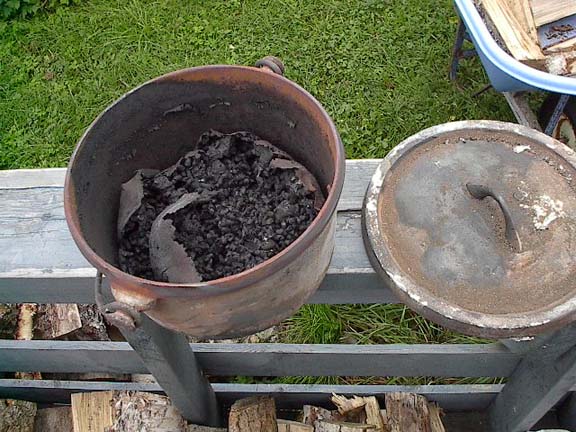
My guess is the temperature was about 800 degrees too high - these were clearly has-beans. I now use the electric crockpot.
-
Before starting this foodblog I was assured that there would be something to go wrong, and not to despair because readers love the bloopers and they are very understanding. The closest thing yet to a blooper was other day - we had some family over for dinner and I had a small fresh turkey in fridge. I love doing birds of all sizes on the gas grill, behold this plate of delicious quail:

The last time I did a barbecued turkey it turned out great :
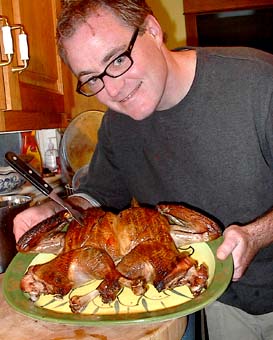
So my goal was to bone and butterfly like before. I started the surgery and began to notice strange deposits of fatty material. I'm thinking "some kind of enlarged lymph glands?" and "do turkeys have lymph glands?" This shiny yellow gooey stuff is . . . butter. Its a butterball turkey - it never occurred to me what the interior of a butterball looks like. Its quite disgusting, all I could think of was a crazed machine with a dozen arms and in each was syringe full of liquid butter, stabbing the carcass over and over, leaving behind these yellow subcutaneous deposits. I think the butterball concept relies on roasting the whole bird in the traditional holiday breast-up position, without removing the back and other structures. It was a complete mess, the butter had mixed with the raw juices to make a weird slurry and I wound up placing the mangled pieces on a tray in the oven. It tasted fine, the wings were especially buttery.
-
Here are a few close-ups from our yard yesterday. For the gardeners out there we are a zone 5b/6a but we also get quite a bit of fog in our bay so things that like a lot of sun don't do so well here:
the rhubarb looks good to go:
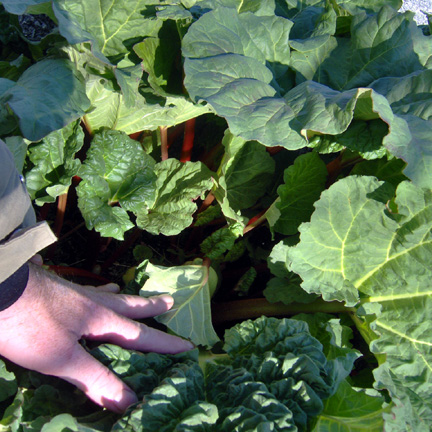
lots of chives:
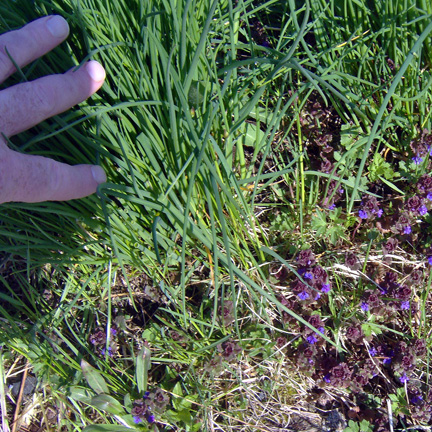
wild strawberries, delicious but tiny:

lupins, not edible but will be colourful:

tomato transplants ready to go, plus some seed potatoes:
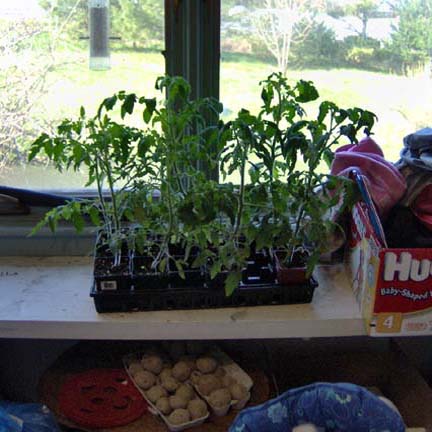
this one is from last year, shows the wild irises:
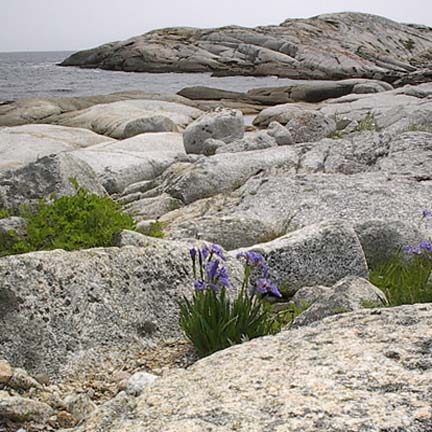
Shad Bay sunset:

There are also plenty of wild blueberries and blackberries around, but my favourite is the pitcher plant (Sarracenia purpurea). Why? Because it is carnivorous. They grow all over the bogs and barrens of granitic Halifax County. I'll look for a photo to post later.
-
Hiroyuki, let me say I enjoyed very much seeing Honshu through your eyes a few weeks ago in your eGullet foodblog.
I was served the crabs by my wife Sandra and ate only claws and legs. Interestingly, when I asked the salesperson about eating the Jonah crabs, she told me most people sick to the appendages but her Asian customers (Mandarin I think she said) like to eat the shell meat as well.
-
The other day we drove to nearby Ketch Harbour House to meet up with Joel and Kim, two extremely enthusiastic and hospitable foodlovers. They have fixed up a very old cape style house right on the ocean and are now set up offering tasting menus out of their home/restaurant. What a place! Next time I am going by boat.
The two of them have considerable experience in the food industry, including their time Toronto’s Avalon Restaurant. Joel is one of the few people in Canada right now who is doing artisinally cured meats. His products are also being sold around Nova Scotia (Hubbards Farmer's Market, Salt Shaker Deli, Fleur de Sel in Lunenburg)
You might also recognize him from FoodTV’s “Man Made Food”.
Here’s what we sampled:

From L to R: Toscano salami (pork), goose prosciutto, beef bresaola, and Moroccan-spiced cured lamb leg.
And then we had littleneck clams steamed on the wood stove with white wine, garlic finished with fresh jalapeño, cilantro and crispy housemade tesa (a flat-style pancetta).
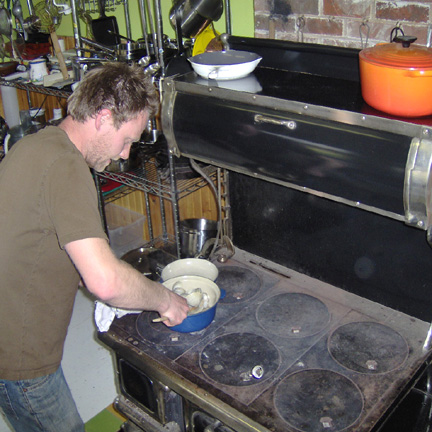
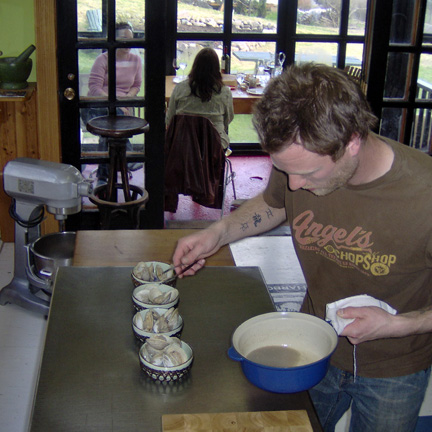
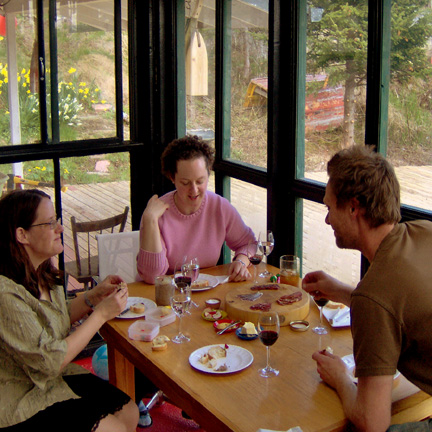
Here's the dining room:
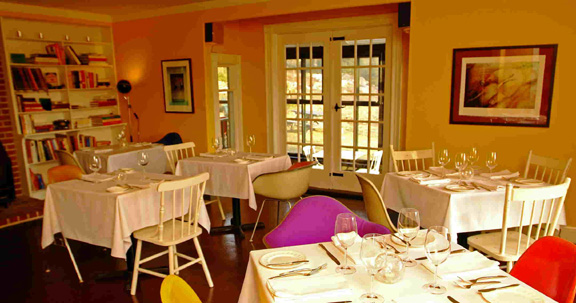
And here's the fridge in the dining room:
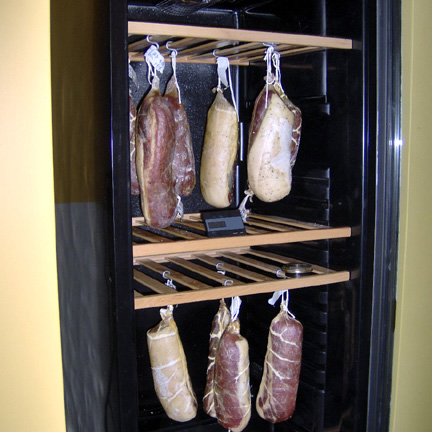
And I can't help but sense a strong dedication to craft when I see Joel's forearm tatoo:

-
Do you yourself like to cook or eat Lebanese or Greek food? You mentioned upthread the possibility of a lamb tagine (which is neither, I realize). I'd be all for that. If you have time and inclination to show some of the Middle Eastern influence up there, that would be great too.
Greek and Lebanese food seem to have a lot in common - Cyprus is probably not even a hundred miles off the coast of Lebanon. Around here there's such high quality Mediterranean take-out its hard to do much better at home. I like to make moussaka and hummus but thats about it. I guess kebabs count too. We just had a chicken tagine and I took pictures so they'll be posted soon, and if I remember I'll take some pics downtown of the best stuffed grape leaves I know.
-
How Acadian food evolved into Cajun food is another question entirely.
eGullet member Marcelle Bienvenu coauthored a book on this subject, "Stir the Pot".
Sounds like a book I'll check out. Just say out loud: "Acadian" and then "A Cajun". Hmmm.
So Peter, how'd your culinary interests and talents develop?
My food interests have been escalating steadily for 20 years but I have never worked in a restaurant or taken any classes. I think we all need an avocation.
And kudos to you for feeding your kids what you eat.
We often offer the kids our food but they don't always go for it. Every day is different.
-
Crabs!
This is a local (cooked) Jonah crab:
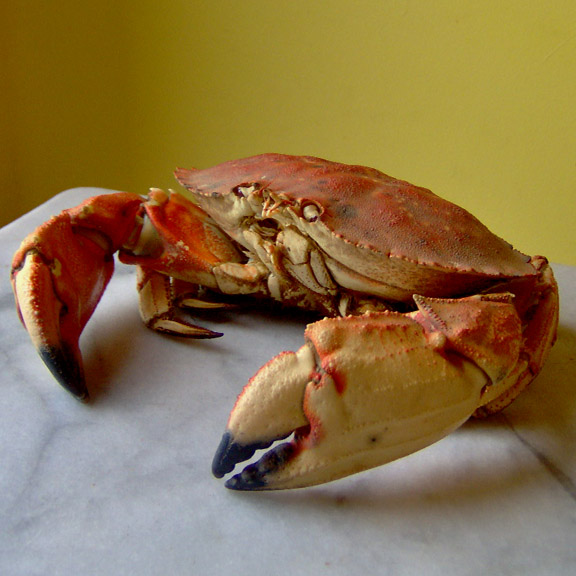
We had planned a trip to a herb farm but it was too rainy, so instead we went to some seafood markets in nearby Bedford.

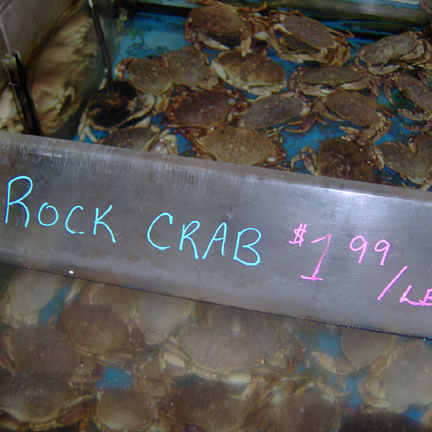
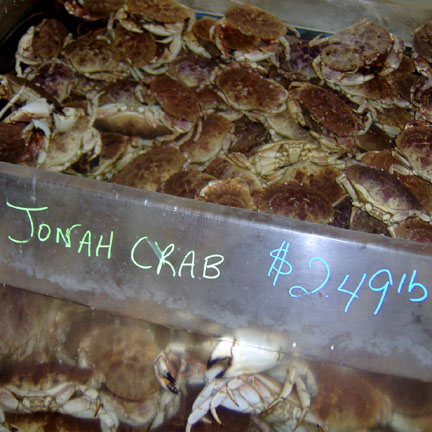

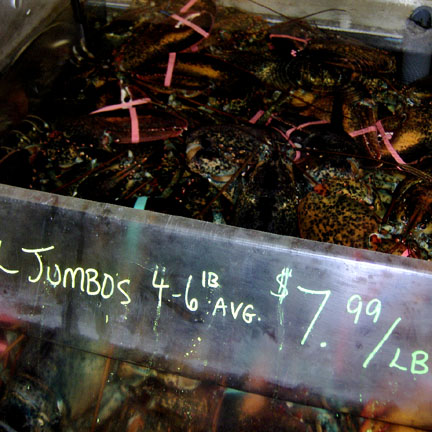
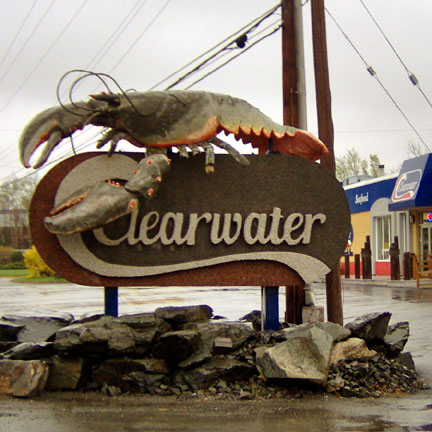

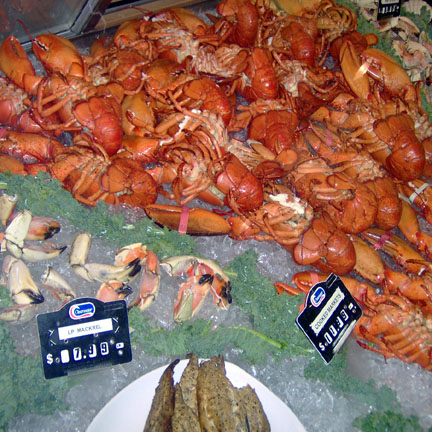


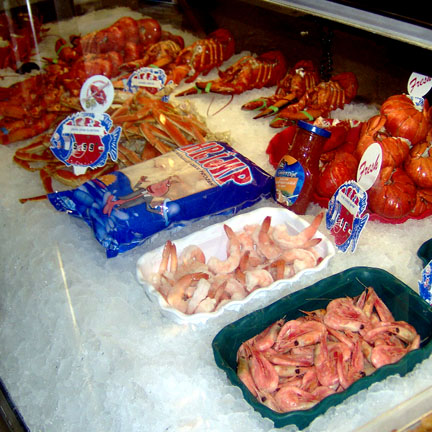
I figured this was a good time to challenge Sandra to a "black box". We have done this a few times before while posting on eGullet - its a lot of fun to get a few surprise ingredients together, spring them on your spouse and then say "can you have dinner ready in two hours?"
Here are the box items:

That's 3 Jonah crabs, local maple syrup, leeks from who-knows-where, and an emu steak which although not indigenous to Nova Scotia came from an organic farm 75 km away in Windsor, NS.
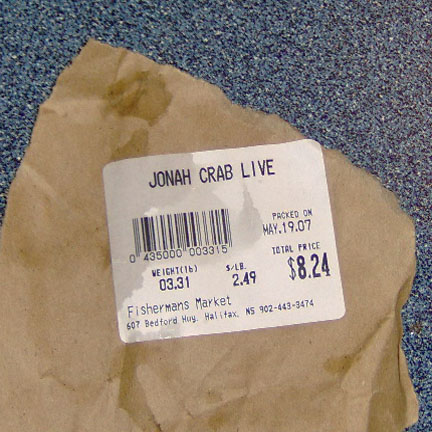

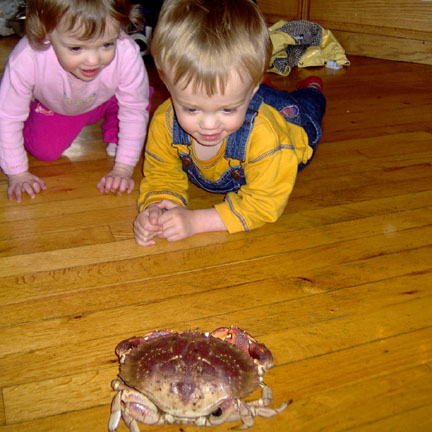
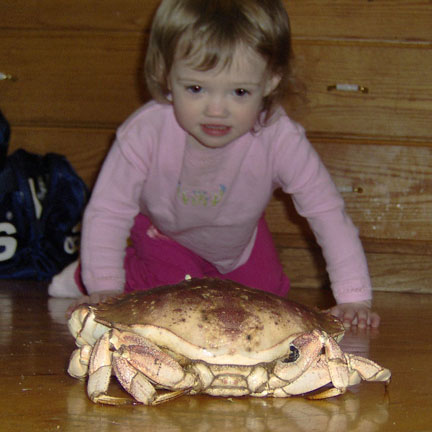
a delicious curried soup with crab leg and claw meat:
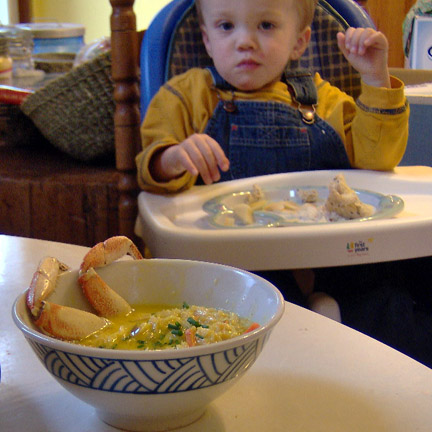
a rare emu steak with a hot spinach salad and basmati rice:
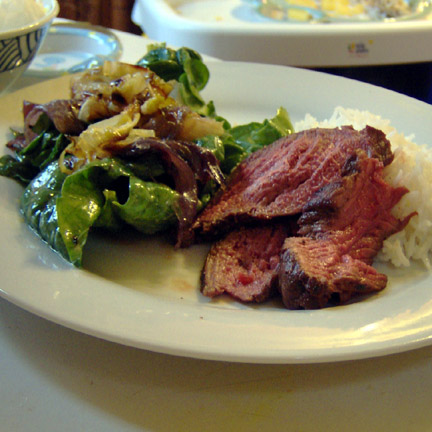
hardly looks like bird meat to me, very lean and mild:
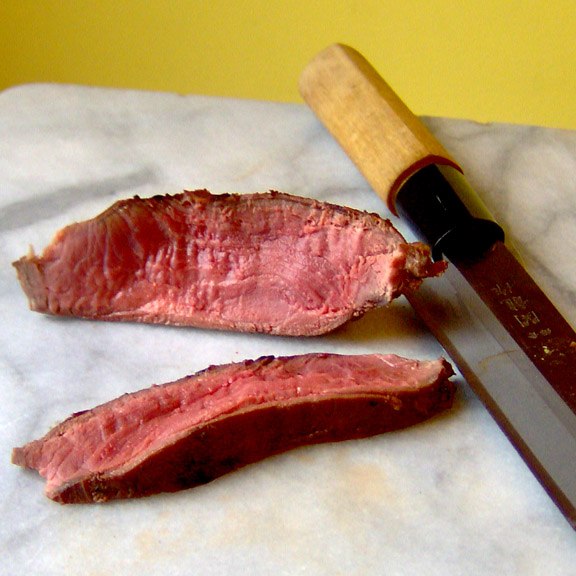
maple angelfood cake with maple whipped cream and maple candy:

It was a delicious way to stay out of the rain.
-
Why is it called a canner?
Canners or "shack" lobsters are too small to be legally exported as live whole lobsters, so they wind up at the roadside shack for local consumption or they get canned. Apparently Canada exports 90% of the lobster catch.
Mid-range lobsters re sometimes called "chickens" and the bigger ones around 5 lbs are "jumbo". Most people like them between 1 and 2 lbs.
Rules are a bit different in the USA for max. and min. legal sizes but both countries go by carapace length - from eye socket to start of tail. A female with a 5" carapace would be considered a big egg-layer and therefore goes back into the ocean. Here I think the min. carapace is 63.5 mm (2.5 inches)
-
Lobsters!
For the few who don’t recognize this creature:
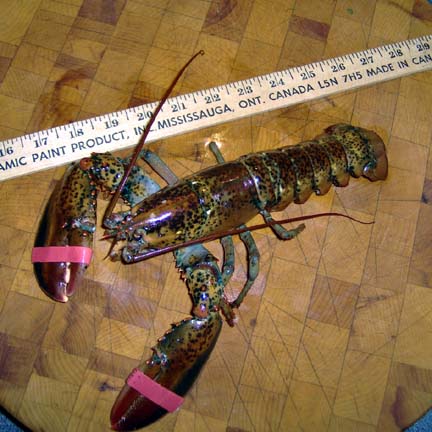
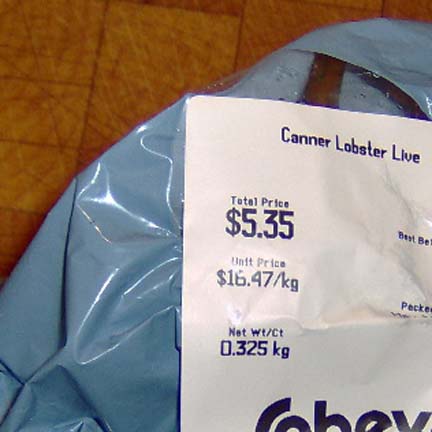
It’s a young lobster (Homarus americanus) weighing in at 325 grams which is almost 12 ounces or ¾ pound. They are cold water crustaceans and extremely delicious. The rubber bands are on the claws to protect other lobsters in the tank and to a lesser extent me (I did see a bigger one snap a pencil in half once). The bigger claw is the crusher and the other is the pincher. Somebody near here once caught a 45-pounder which I believe is the word record.
I put him head first into an inch of boiling water for a quick kill then let him steam for 15-20 minutes. That’s it, pink and delicious! Some like them cold – an easy way to go when you’re cooking up a few dozen. Melted garlic butter is mandatory:
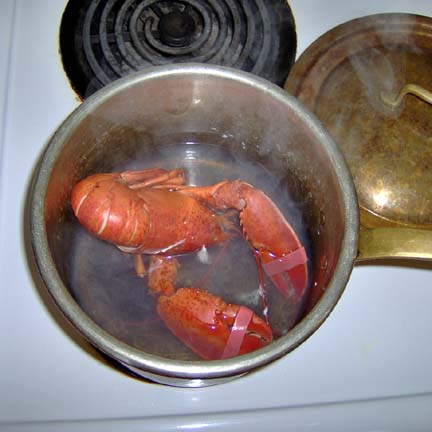
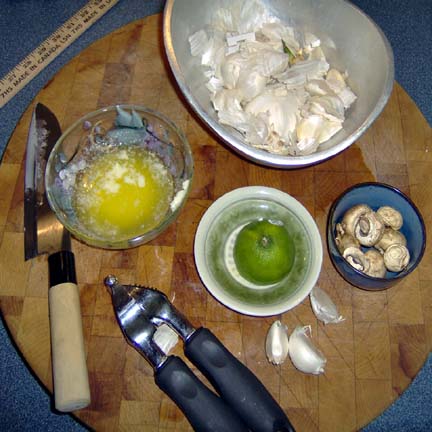
This guy is missing 3 ½ of his walking legs (amazingly, they can regrow them):
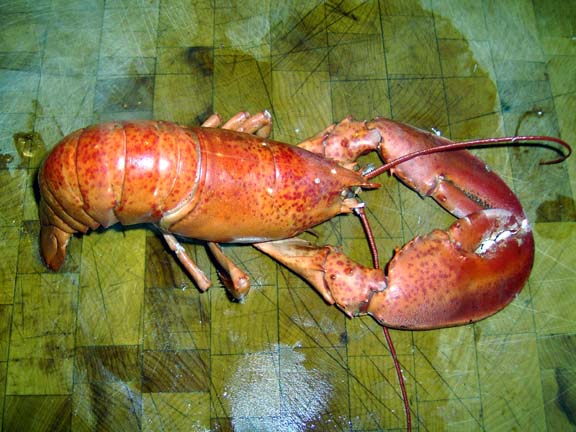

So you twist off the tail and snip up the centre of the underside, the tail meat should come out in one piece. Crack the claws and work the juicy white meat out. The green stuff (aka tomalley) is the liver equivalent and it is one of the best tasting parts, to me anyways. Like other creatures it also tends to be a place for toxins to accumulate so some skip it. I mix it with some of the garlic butter and smear it on a bun.
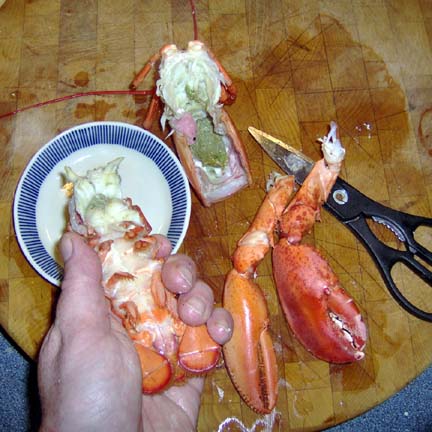

In order to grow they must molt. Most adults replace their entire shell every few months depending on a number of factors. This guy was likely preparing to molt since the meat was tightly packed inside a very hard shell. If you are lucky you might get a female with tens of thousands of flavorful eggs. The males are generally bigger but I can’t tell gender without seeing the eggs inside. There is a way; some kind of tiny anatomical thingy that I can never find.
After processing, I got around 120 grams of edible flesh and 150 grams of shell, etc. That’s 325 – 120 – 150 = 55 grams still in the pot.

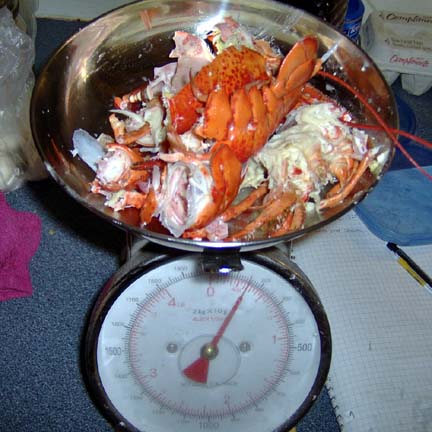
So I put the shell bits back in and simmer the whole lot for lobster stock. That’s one of the reasons I don’t boil the lobster; way too much water to reduce into a flavorful broth. I’m going to add the stock to sautéed onions, then add frozen shrimp, sole and corn (celery, carrot, potato etc. to follow).
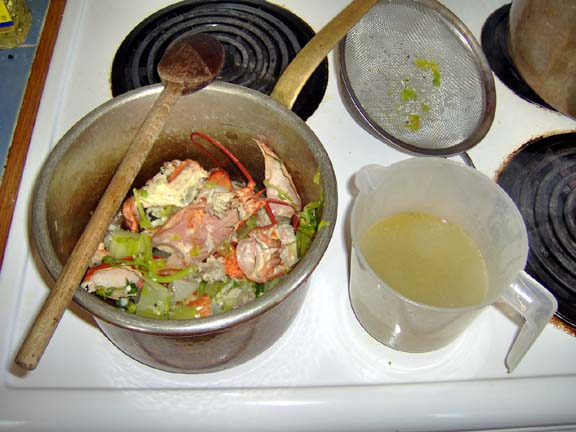
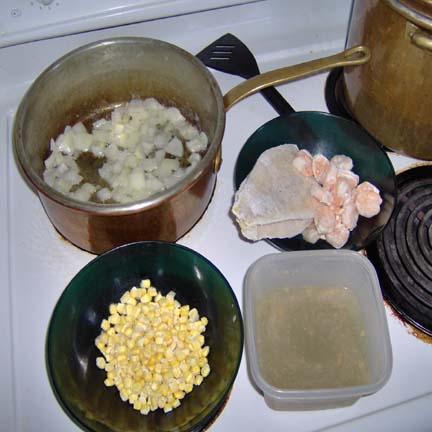
Here’s lobster served with some sliced beef, bib lettuce, Vidalia onion, and a Chianti.
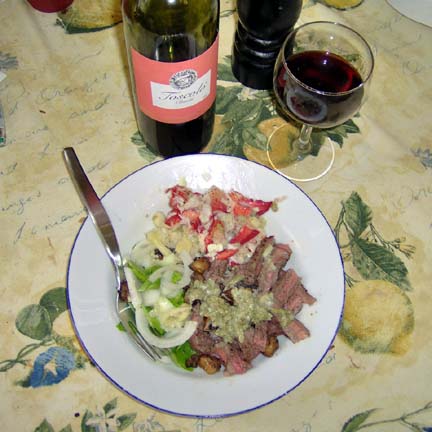
And a big glass of the chowder.

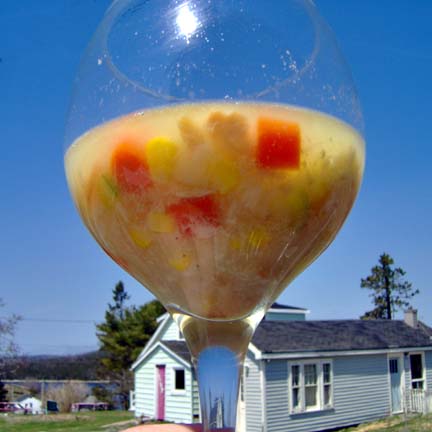
-
That chunk of monkfish looked like part of a human anatomy model.
 The way you smoked is very intriguing though.
The way you smoked is very intriguing though.Yes, the monkfish looked like the aftermath of whatever-ectomy operation. Tastes great though, especially if all you see is a juicy medallion on your plate. The wood added a tiny bit of smokiness and colour, but nowhere near that of a hot or cold smoked fillet. Cleanup was real easy too!
-
Pickled herring, right?
How'd it get the name "Solomon Gundy"?
Isn't that a Mother Goose rhyme? ("Solomon Gundy, born on a Monday...")
Yes it is pickled herring, with some onion and spices. The story I know is that the name comes from salamagundi which is an old English style of salad with all kinds of stuff in it, including fish.
Solomon-a-Gundy is mackerel and shad boiled together, from Jamaica.
Solomon Grundy with an r is a Victorian English nursery rhyme:
Solomon Grundy,
Born on a Monday,
Christened on Tuesday,
Married on Wednesday,
Took ill on Thursday,
Grew worse on Friday,
Died on Saturday,
Buried on Sunday.
That was the end of
Solomon Grundy.
Solomon Grundy is also a bad guy zombie in the comic books.
-
Nova Scotia is latin for New Scotland; owing to a number of Scottish settlers who . . .
nakji, thanks for the historical synopsis. Halifax is a port city so there are lots of new Canadians, and its a college town so there are lots of international students.
I'd add that today the second most spoken language in Halifax is Arabic. There are thriving Lebanese and Greek communities here and its easy to find food associated with those cultures.
Now that I've thought about it a bit, I can't think of a particular dish strongly associated with Halifax. Donairs, perhaps?
I plan on getting a donair (aka gyro) for blog purposes but like poutine (aka disco fries) it helps to have the right conditions - after midnight, busy street scene, elevated blood alcohol, etc.
-
Another kid fave is chicken strips.
This is thigh strips in egg and whole wheat flour:
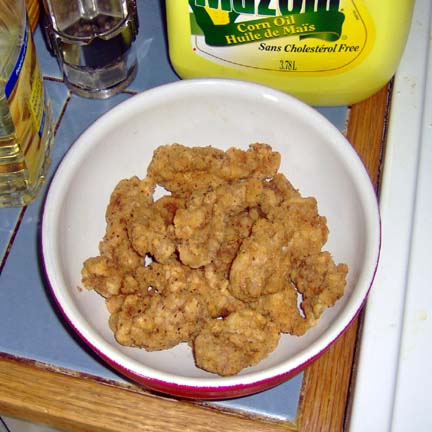
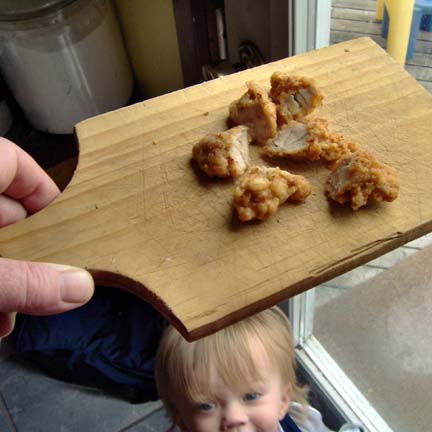
And they're just now liking local pickled herring and blue cheese:
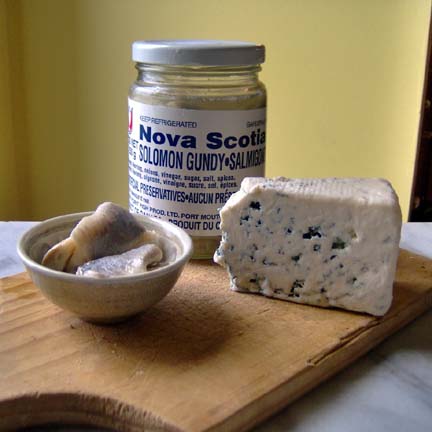
-
Peter, talk about feeding yourself and the kids during the day. Breakfast, lunch and snacks.
Susan, that is a good question because at this stage every week seems to be different. I stopped worrying about individual meals and started asking "has it been a good food day or week?" My guys who are almost two years are total mimics, so if I sit down with them and make sounds of joy as I eat the oatmeal they will usually follow suit.
So we had some pasta and cheese together for lunch the other day:
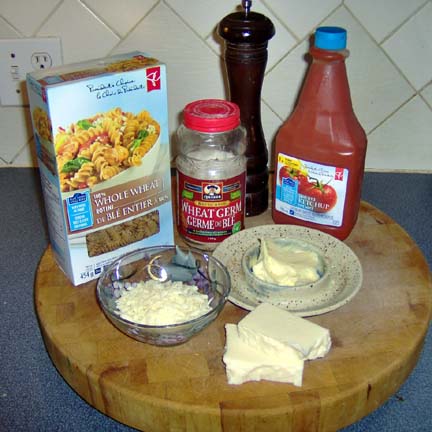


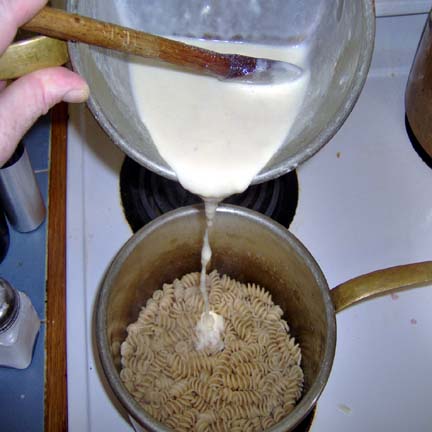

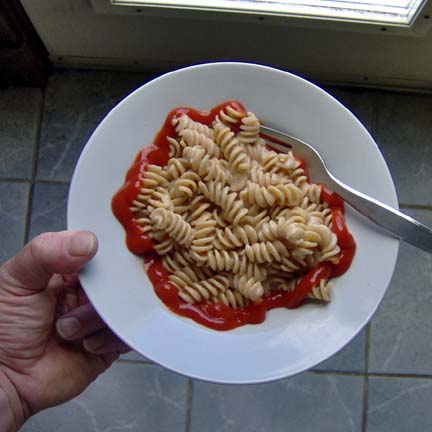

We also made some BBLT's - back bacon lettuce and tomato sandwiches.
Also known as CBLT's - Canadian bacon lettuce and tomato sandwiches -
either way worthy of a national title.
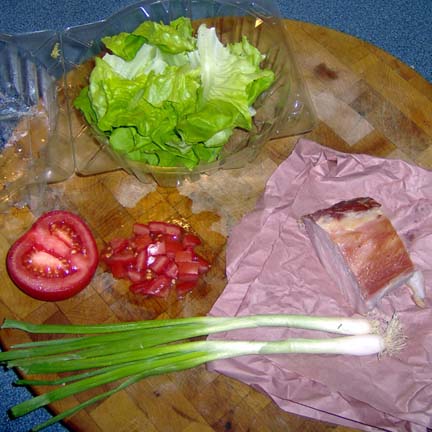
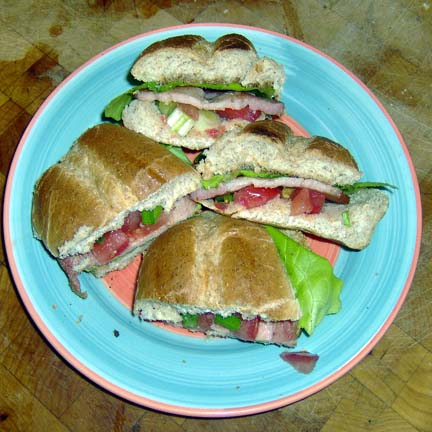
Snacks are usually around 10:30 am and 3 pm. Any kind of fruit, juicy or dried, are very popular. We try to have real raisin toast with imaginary tea in the afternoon. My modus operandi is to offer good stuff to them, pretend to eat it with them, and when they don't, I do so undetected.
-
Good heavens. The prices on the shrimp and crawfish blew me away. I know the crawfish isn't local, but are there no local shrimp as well?
Around here, the crawfish, cooked, are $1.29-2.99 per lb and that size of cooked shrimp would run maybe $6-7 per lb.
At those prices, it is no wonder you went with the monkfish.
I'm glad you saw that. I honestly don't know how the shrimp market works around here, but whenever I get the frozen bag it says:
cultivated cooked shrimp
product of: Thailand, Vietnam, China, India, Indonesia
By the way what's a crawfish?
-
Peter, I noticed that prices are given by the pound, not the kilogram(me) in the supermarket. Is that a regional thing? I seem to remember that in Quebec and points west, the metric system is used pretty much exclusively.
It's not a regional thing, it's just a stupid thing - it drives me crazy! I often see stuff at both major grocery stores here priced by the pound but the scale nearby is metric. And vice versa, I would provide a picture but I have been forbidden to take photos. I can do the math, but we all have a breaking point.
I am proud that we live in a country with two official languages, but we are supposed to be metric. I like the Imperial system just as much, I just resent being offered a price in one and a scale in the other. If I wasn't so lazy I'd write a letter.
-
So tell me a little about Dragon's Breath Blue. What's its taste? Raw milk, I assume?
Gabrielle Bright, The Canadian Living Test Kitchen says it well:
Described as a little brother to Stilton, Roquefort and gorgonzola, this black wax-covered cheese develops mould around the sides (stirring it up and waiting a couple of days help activate it even more). We loved its creamy yet chalky texture and mild blue flavour, but it sure does stink (hence the name).
I noticed that the dulse was identified as a "Product of Atlantic Canada." I have heard that when the Quebecois repeatedly threatened to split Canada in two, there were people in the Atlantic provinces who thought that eastern Canada should either go it alone or join the United States. Was that sentiment at all widespread? Is it still alive, now that it looks like Quebec separatism is in retreat?
Politics, eh? No comment. I'll just say this:
Nova Scotia + New Brunswick + Prince Edward Island = The Maritimes
The Maritimes + Newfoundland = Atlantic Canada
Atlantic Canada + Quebec + The Rest = Canada
-
As promised here are some shots from Pete's Frootique. It's food retail at its best and a great place to poke around and plan menus. I picked up some goodies to prepare later this week. . .
fiddleheads (today down to $3.99/lb)
[
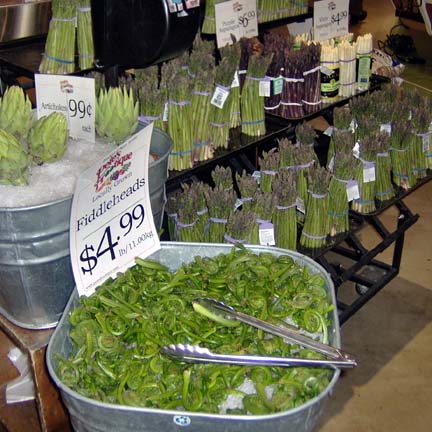
more greens:

nuts, dried stuff, etc.

dried, smoked, cured meats:
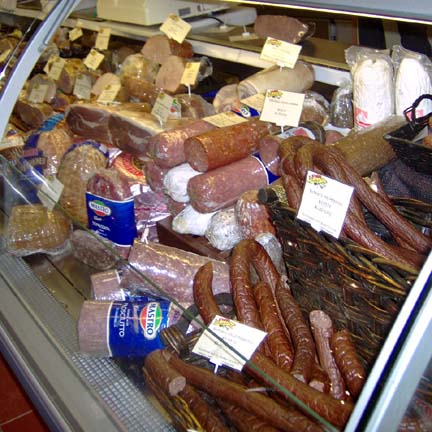
lots of European chesses, a couple are local:
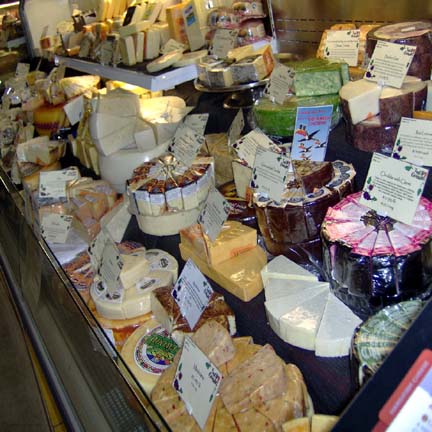
more cheese:
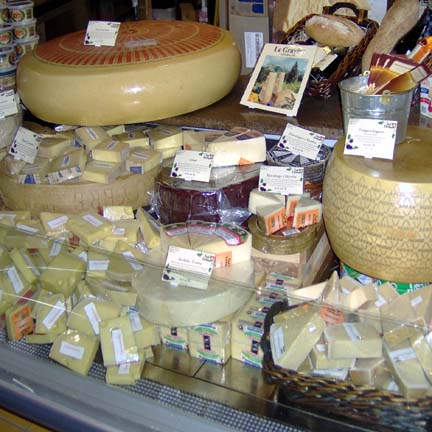
frozen boar, emu, venison, duck, bison, etc:

fresh sausage made on premises:
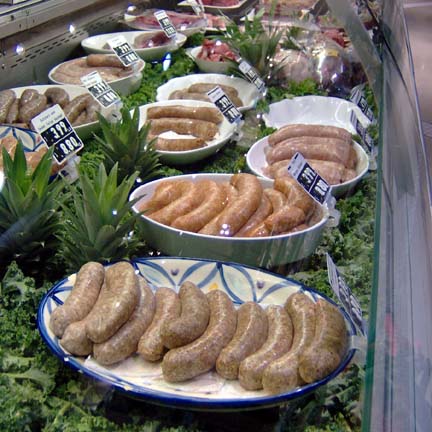
rolled up stuff, haven't had, looks good:
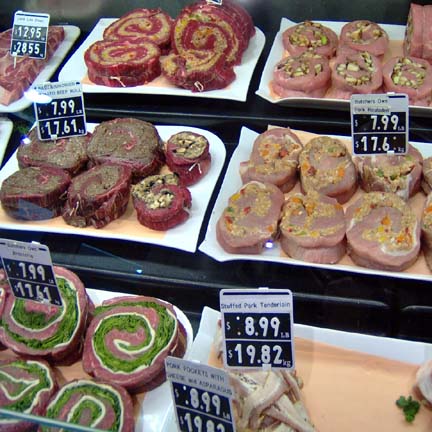
lots of fresh red meat:
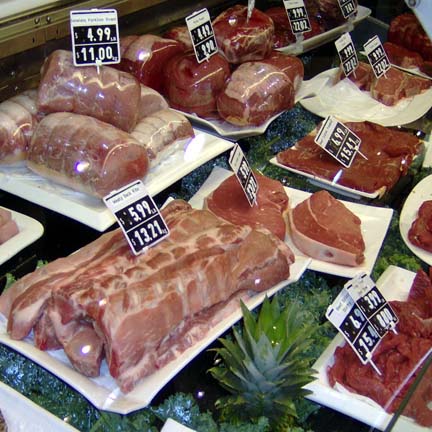
note the Nova Scotia jumbo squid:
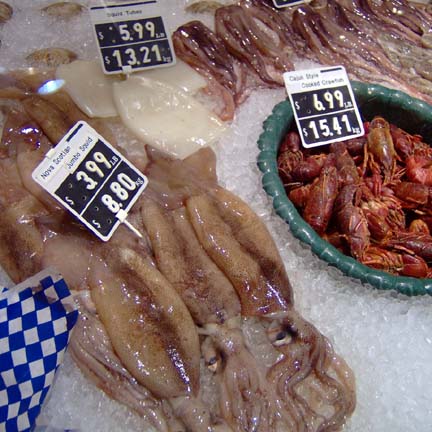
ribbit, ribbit:

red snapper looks good:

-
That monkfish looks delicious! I can't get over how cheap it is... It used to be that cheap here -
I don't usually see monkfish at the fish market so I cannot say if this price is typical. I know it is a by-catch that comes with other more plentiful groundfish. It often shows up on the restaurant menus though.
-
This is not traditional at all, in fact I have never seen anything done this way. I was looking for my stash of cedar shingles in the shop, saw the veneer and had a "light bulb moment".
I have not (knowingly) had the liver.



eG Foodblog: Peter the eater - Nova Scotia Eats
in Food Traditions & Culture
Posted
tejon,
You asked about bagged milk - you can see it in the next batch of pix. You can buy 3 bags (4 litres) for $5.19 up to $7.35 around here. And the empty bags work perfectly in my kitchen shrinkwrapper.
Here I am preparing 6 chicken thighs for a Thai red curry coconut in the tajine. The other 6 are being frozen. With the sale, the thighs work out to just under 50 cents each (my keyboard doesn't seem to have the $-like character for cents)
This vessel is good for this kind of thing because it goes from stovetop (for browning) to oven (for slow cooking) to tabletop (for eating) and its supereasy to clean.